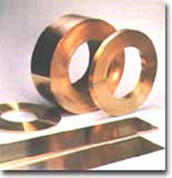Copper and copper alloys are frequently used for electrical and electronic device parts because they excel in electrical and thermal conductivity, spreadability, drawability, corrosion resistance, spring characteristics, and so on.
| Type (JIS) | Features | Uses |
|---|---|---|
| Copper and dilute copper-based alloys (C1000s) (1) Oxygen-free copper (C1020) Purity 99.96% or more (2) Tough pitch copper (C1100) Purity 99.90% or more (3) Phosphorous deoxidized copper (C1201,C1220,C1221) (4) Beryllium copper (C1700,C1720) Be 1.6 – 2.9 |
- Including little alloy elements - Electrical conductivity, thermal conductivity, spreadability - Same as above - Excellent electrical conductivity - Excellent spring characteristics (age hardening) |
- Electrical parts, electrical machine parts - Electrical and electronic device parts - Springs, connectors |
| Copper-zinc alloys (C2000s) C2600,C2680,C2720,C2801 Brass Cu: 70 – 60%, Zn 30 - 40 |
Spreadability, drawability | Wiring devices, electrical machine parts, etc. |
| Copper-zinc-lead alloys (C3000s) C3560,C3561,C3710, C3713 Free-cutting brass |
Machinability | Watches, gears, etc. |
| Copper-zinc-tin alloys (C4000s) Naval brass C4621, C4640 |
Corrosion resistance | Tube plates of heat exchangers, etc. |
| Copper-tin-(lead) alloys (C5000s) Phosphor bronze |
High electrical conductivity, stress relaxation resistance, thermal resistance, bending workability, spring characteristic | Switches, connectors, etc., for electronic and electrical measurement hardware, etc. |
| Copper-nickel alloys (C7000s) Nickel silver |
Spring characteristic | Switches, connectors, etc., for electronic and electrical measurement hardware, etc. |
(新素材へのめっき技術の開発と合金めっきの新しい用途開発、 全国鍍金工業組合連合会・活路開拓調査指導事業委員会編より)

Copper-based materials
Types of plating